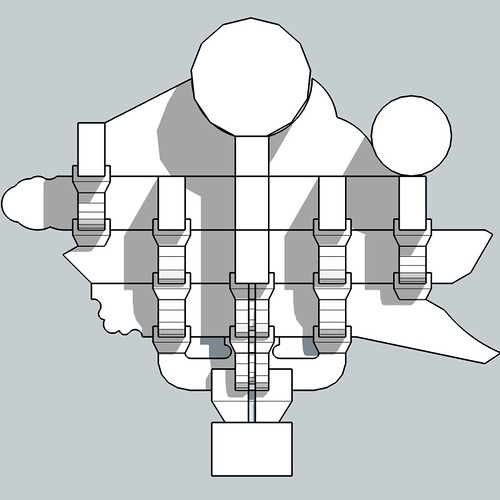
kosong yang PENUH
Sunday, October 2, 2011
Sunday, August 14, 2011
ARCHITECT





apa ada hal.




Thursday, November 11, 2010
Tri Angga

- The spatial hierarchy, Tri Loka or the so called Tri Angga.
Tri Angga is the fundamental concept which is closely related to the architectural planning of which Tri Hita Kirana originated. Tri Angga divided everything into three main components or zones:
- Nista (underneath, dirt, foot)
- Madya (center, neutral, body)
- Utama (above, pure, head)
There are three poles where building construction in Bali is based on, these poles include:
- Hydrosphere, lithosphere and atmosphere (Bhur, Bhuwah and Swah)
- The rising and the falling of sun (kangin-kauh)
- Mountain and sea (nature)
From these poles, the people of Bali acknowledge the concept of cosmic orientation, Nawa Sanga or Sanga Mandala. Physical transformation of this concept on the architectural design is the guideline in the setting of typical Balinese houses.
Angkor Wat

Angkor Wat is the prime example of the classical style of Khmer architecture—the Angkor Wat style—to which it has given its name. By the 12th century Khmer architects had become more skilled and confident in the use of sandstone (rather than brick or laterite) as the main building material. The Angkor Wat style was followed by that of the Bayon period, in which quality was often sacrificed to quantity.

It is a work of power, unity and style."Architecturally, the elements characteristic of the style include: the ogival, redented towers shaped like lotus buds; half-galleries to broaden passageways; axial galleries connecting enclosures; and the cruciform terraces which appear along the main axis of the temple. Most of the visible areas are of sandstone blocks, while laterite was used for the outer wall and for hidden structural parts. The binding agent used to join the blocks is yet to be identified, although natural resins or slaked lime have been suggested. Other elements of the design have been destroyed by looting and the passage of time, including gilded stucco on the towers, gilding on some figures on the bas-reliefs, and wooden ceiling panels and doors. Typical decorative elements are devatas (or apsaras), bas-reliefs, and on pediments extensive garlands and narrative scenes. Statuary is conservative, being more static and less graceful than earlier work.

Architectural Style
This temple was dedicated to Hindu God Vishnu by the Khmer kings and it truly represents the classical and appealing Khmer architecture. Angkor Wat temple is highly renowned in Cambodia that is why it also appears on the national flag of this beautiful nation. The temple is constructed with mainly sandstone, laterite and other materials. Various famous archeologists have also compared this temple to the famous castles of Europe.
Key Features of the Temple
The temple is designed keeping in mind the South Indian Hindu architecture. This complex has a temple mountain and other key features like the galleried temple and Jagati. The temple was made keeping in mind the Mount Meru which is believed to be the home of Hindu Gods.
Decorations
Angkor Wat is known all around the world for its classical decorations and descriptive structures. Inside the temple you will find most of the walls covered with scenes that depict some chapters from the great Hindu epics, The Ramayana and The Mahabharata. Various famous battle scenes are also depicted on the walls. One great scene is depicted on the eastern gallery wall of this temple. This scene shows the “Churning of the Sea of Milk” with 92 asuras on one side and 88 devas on the other side.
The Present Condition of The Temple
After being rediscovered, the temple has gained immense popularity all around the world. Conservation efforts are still going on in various parts of the temple. The temple areas which were in extremely poor condition due to deterioration and natural erosion are now being restored.
Mandala

The Mandala is a symbol of man or woman in the world, a support for the meditating person. It is often illustrated as a palace with four gates, facing the four corners of the Earth and connected with the Buddha Vajrasattva, who symbolises the original crystalline purity. In the centre is a lotus blossom with eight petals, resting on a bed of jewels.

fire of wisdom: the outermost circle consists of the purifying fire
vajra circle: the diamond circle expresses strength and fearlessness
tombs: there are eight tombs, which symbolises the eight states of consciousness*, which the person must go beyond
lotus circle: expresses the open state of devotion, that is necessary to enter the palace
Centre

The symbol of Buddha lives in the centre, surrounded by eight Buddhas for meditation - symbolic deities: four male and four female. These figures, facing the corners of the earth form together a lotus flower.
Buddhas for Meditation
Symbols
Bell: the female part of the Tantric polarity: the symbol of emptiness - the boundless openness, giving room for wisdom
Vajra: the male part of the Tantric polarity: the symbol of effective means and Buddha's active compassion with the meditating person. Originally it was the thunderbolt of the god Indra, later it came to represent the diamond
Dharma Wheel: the eight hubs are a symbol of the Eightfold Path*, leading to perfection
Lotus: symbol of the teaching of Buddha. The plant standing with the roots in the mud, yet raising its blossom towards the light. You can be like it
*
1. right belief
2. right resolution
3. right speech
4. right action
5. right living
6. right effort
7. right thinking
8. peace of mind through meditation
Dougong




From the point of view of structural mechanics, the dougong structure is highly resistant to earthquakes. It could hold the wood structure together even though brick walls would collapse in the same earthquake. This helped so many ancient buildings to stand intact for hundreds of years.
